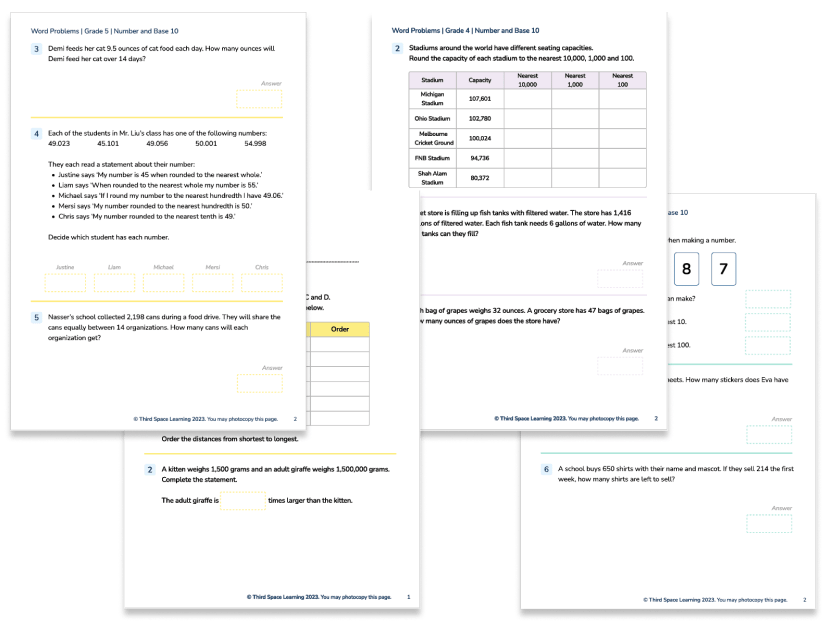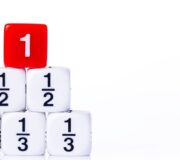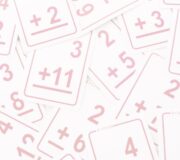20 Multiplication Word Problems for 3rd to 5th Grades With Tips On Supporting Students’ Progress
Multiplication word problems are mathematical word problems that use real-life scenarios involving multiplication to find the solution. Multiplication word problems teach students to apply their knowledge of their times tables and build up skills in standard algorithm multiplication.
As children advance through elementary school, they will develop their times tables skills. Skills to tackle word problems involving multiplication develop alongside this from 3rd grade to 5th grade.
How to build mathematical skills to tackle multiplication word problems
As children develop their knowledge of multiplication, it is essential that they are exposed to visuals and concrete manipulatives to understand the concept of multiplication. These resources aim to aid children’s understanding of multiplication and allow them to make connections to real-world situations.
Multiplication Word Problems For 3rd - 5th Grade
Develop your 3rd - 5th grade students multiplication reasoning and problem solving skills with these 10 questions and answers per worksheet!
Download Free Now!As children become more confident in their ability to multiply they will start to apply their skills to beyond one-step problems and begin to solve complex word problems, and multi-step problems that may involve more than one operation.
In two-step problems children may need to use their addition word problems, subtraction word problems, fraction word problems and division word problems skills to find the solution. These skills are built upon throughout lower and upper elementary. Furthermore, having a student who understands place value will also aid them in their problem solving skills.
It is important that children are exposed to arithmetic activities and fluency tasks together with regular word problems. To help, in this blog you will find multiplication word problems for all grades from 3rd grade up to 5th grade, complete with examples and solutions for you to use with your students.
Multiplication in 3rd Grade
In 3rd grade, children should be able to recall all products of two one-digit numbers and division facts for these tables. Additionally, they begin writing the multiplication, division and equals signs and show that multiplication of two numbers can be done in any order due to the commutative theory.
They will also develop efficient mental methods using commutativity and associativity such as 5 x 8 = 40 and so 8 x 5 = 40 as well as deriving related facts such as , if 2 x 3 = 6 then 20 x 3 = 60. Students will also practice their written multiplication strategy starting with calculations of two-digit numbers by one-digit numbers via arrays and area models.
3rd graders use arrays, repeated addition, concrete materials and mental methods to solve word problems. By the end of 3rd grade, they also begin to successfully write and calculate multiplication statements and solve missing number problems.
It is also important to develop our students’ vocabulary and to consider the different ways of saying we are multiplying. Multiplication word problems are fantastic at doing this by using phrases such as ‘the product of’, ‘equal groups’, ‘use multiplication tables’ and ‘arrays’. Concrete materials will obviously assist in this understanding too.
By the end of 3rd grade students will mentally know and use place value to understand about multiplying by 10 and 100, recognize and use factor pairs and be able to multiply three-digit numbers by one-digit numbers.
When working on multiplication word problems, students will look at integer scaling problems and more complex correspondence problems such as ‘n objects are connected to m objects’. These two-step problems will be based on real-life scenarios around: measure, money and fractions.
READ MORE: Math Problems For 3rd Graders
Multiplication in 4th and 5th grade
In 4th grade, students continue to practice multiplying using the area model, multiplying 4-digit by one-digit numbers. In 5th grade, students are introduced to standard algorithm multiplication, where students will multiply 4-digit numbers by two-digit numbers.
Children should use their knowledge of factors, multiples, and prime numbers to assist them in their problem solving. Being familiar with multi-step word problems and knowing how to apply their knowledge of multiplication in a quick, accurate manner is essential.

Meet Skye, the voice-based AI tutor making math success possible for every student.
Built by teachers and math experts, Skye uses the same pedagogy, curriculum and lesson structure as our traditional tutoring.
But, with more flexibility and a low cost, schools can scale online math tutoring to support every student who needs it.
Find out moreWhy are multiplication word problems important for children’s understanding of multiplication
Word problems are a great opportunity to bring math to life. They enable children to see the link between the math they do in the classroom and how they can apply it in real-life scenarios and avoid the phrase ‘why do we need to learn this anyway?’
In lower elementary word problems allow for the chance to use concrete materials and manipulatives rather than a constant stream of multiplication word problem worksheets.
Children get a hands-on opportunity to problem solve and visually see how to create arrays or use repeated addition. While this continues into upper elementary, learners will use concrete materials less and instead embark on the formal written methods of standard algorithm multiplication so that they become confident with mental and formal methods.
In addition, children develop key skills such as:
- building problem solving skills
- developing mathematical language skills
- develop an understanding between multiplication and division and how we can use, and may need to use both, to solve two-step problems. We may need to multiply before we use standard algorithm division for example.
- be able to apply mathematical concepts to real life situations.
Teaching how to solve multiplication word problems in elementary school
Once the concept of multiplication is embedded and children understand how to use concrete materials, for example how to visually create an array to represent the multiplication needed, the next step is to advance to multiplication word problems.
When providing children with multiplication word problem worksheets or multiplication word problems challenge cards, it is important that children are able to read the question carefully and understand the context before extracting the math from it.
Students need to be able to interpret what they are being asked. What operation do they need to do? Or do they need to do two operations? Is it a one-step problem or a two-step problem? In the word problems below the focus will be multiplication, whether representing it visually, like in lower elementary, or moving up to formal written methods in upper elementary.
Example of a multiplication word problem
Amy is making the party bags for her birthday party. She has invited 10 friends and they will have three chocolates in their bag. How many chocolates will Amy need altogether?
How to solve this:
Firstly we need to know that Amy has invited 10 friends so there will be 10 party bags. She will put 3 chocolates in each bag. So we know:-
- There are 10 friends/party bags
- They will have 3 chocolates each
- We therefore need to multiply, or use repeated addition, to times 10 by 3 to solve the problem.
- So to solve this problem we could draw a number line starting at zero (0) and repeatedly add three (3) each time. We need to repeat this ten (10) times to attain the answer.
- We could mentally use our times table knowledge to do 10 x 3, or 3 x 10 or visually represent this as an array. We could even show this as a bar model.
- We could formally use multiplication to solve this problem.
How would we represent this visually?
Below are visual representations of the above problem to show how a child may represent this problem using any of the strategies above:
How we would represent this with repeated addition:
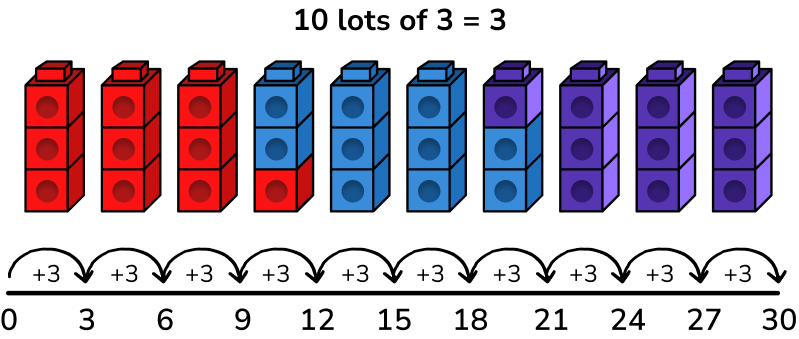
Or as an array:

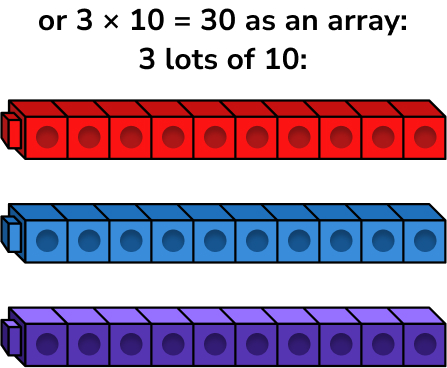
Examples of multiplication word problems in the elementary setting
Below are examples of what can be expected at each grade level from grades 3 to 5. Through Third Space Learning’s elementary math tutoring programs at Third Space Learning, Skye — our one-on-one conversational AI tutor built by teachers and math experts — supports every student to build confidence with word problems, strengthen their vocabulary, and deepen their mathematical understanding. Students encounter word problems regularly, with each lesson personalized to build the skills they need.
Multiplication word problems for 3rd grade
3rd grade is the first year that multiplication is formally introduced. When solving word problems for 3rd grade, students will first use concrete materials to discover how to use repeated addition and arrays to solve word problems that have a context to them. They should be encouraged and aided in representing the word problem visually as well as developing their mental methods to solve such problems.
By the end of 3rd grade, students should be using their full knowledge and recall of times tables to 10 x 10 to help with multiplication of 2-digit and 3-digit numbers by a 1 digit number. Word problems may also involve multi step problems and there will be exchanges taking place too.
Question 1
Mia is picking flowers. A flower has 5 petals on it. How many petals will be on 6 flowers?
Answer: 30 petals
How we can solve this using repeated addition:
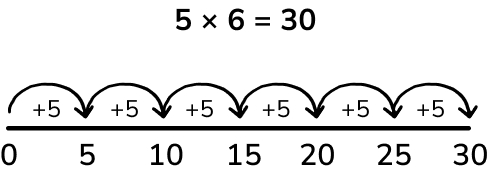
How we can solve this using arrays:
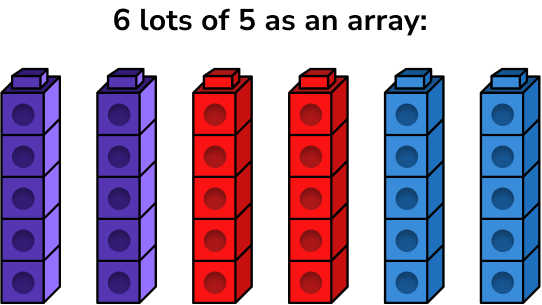
How we can show this visually:

Question 2
Sam is at the store and sees a bouncy ball is 10¢.
Sam wants to buy 8 balls. How much will it cost?
Answer: 80¢
Question 3
Hansi has 4 packets of stickers with 5 stickers in each packet.
Robert has 3 packets of stickers with 10 stickers in each packet.
Who has the most stickers? Why?
Answer: Robert because Hansi has 20 stickers (4 x 5) but Robert has 30 stickers (3 x 10).
Question 4
Daisy and Ollie are sharing some marbles. They have 5 boxes of marbles, and once they have shared them they have twenty marbles each. How many marbles are in each box?
Answer: 8 marbles.
If they have 20 marbles each then in total there are 40 marbles (20 x 2 = 40). If there are 5 boxes of marbles then there are 8 marbles in each box as 40 divided by 5 is 8. Some may also know the inverse here in that 5 x 8 = 40.
Question 5
It is Christmas break and a family of 4 are going to the cinema! Each ticket costs $8. How much would it cost for the family to go to the cinema?
Answer: $32.
As 4 multiplied by 8 equals 32. We can solve this mentally and by knowing the times table fact 4 x 8 = 32 or 8 x 4 = 32.
We could also show this in bar model method:
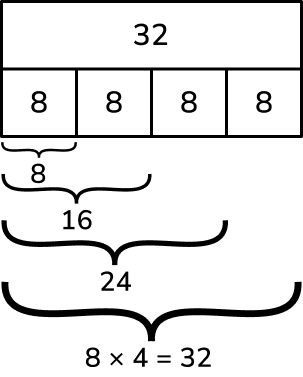
Multiplication word problems for 4th grade
In 4th grade, students should be using their full knowledge and recall of times tables to 12 x 12 as children begin to multiply 4-digit numbers by 1-digit numbers and 2-digit numbers. Word problems may also involve multi-step problems and there will be exchanges taking place too.
Question 1
Jack and Ella are practicing their area models and have both attempted the same question.
The question is: What is 1,235 x 7?
Jack says the answer is 7,259 but Ella says the answer is 8,645.
Who is correct and what mistake has one child made?
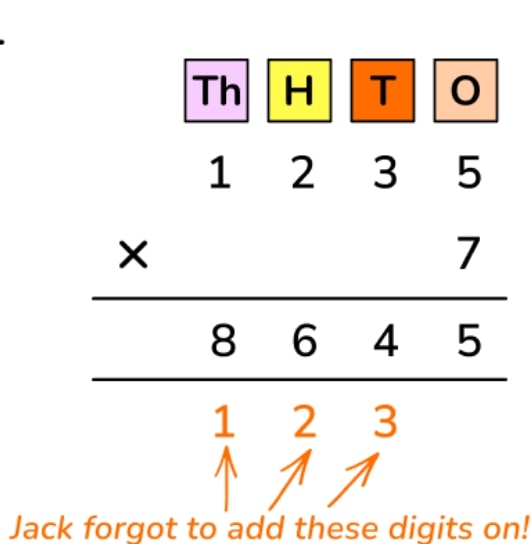
Answer: Ella is correct, the answer is 8,645 and the mistake made is that Jack forgot to add the two zeros when multiplying 7 x 200.
Question 2
If a shop makes $2,782 in a day, how much will it make in one week?
Answer: $19,474
Note: For this question we must know that there are 7 days in one week as we then have to multiply 2,782 by 7.
Question 3
A group of friends go for lunch at the local restaurant. 6 of them decide to buy chicken nuggets and fries which costs $7 each and the other 4 friends decide to buy pizza and salad for $8 each. What do friends spend more on, chicken nuggets or pizza?
Answer: Chicken nuggets
Chicken nuggets = 7 x 6 totals $42 whereas pizza = 8 x 4 totals $32. Therefore, they spend more on chicken nuggets.
Question 4
A high school football team has a mean (average) attendance of 1,298 people each game. There are 9 games in a season, what is the total attendance for the whole season?
Answer: A total attendance of 11,682
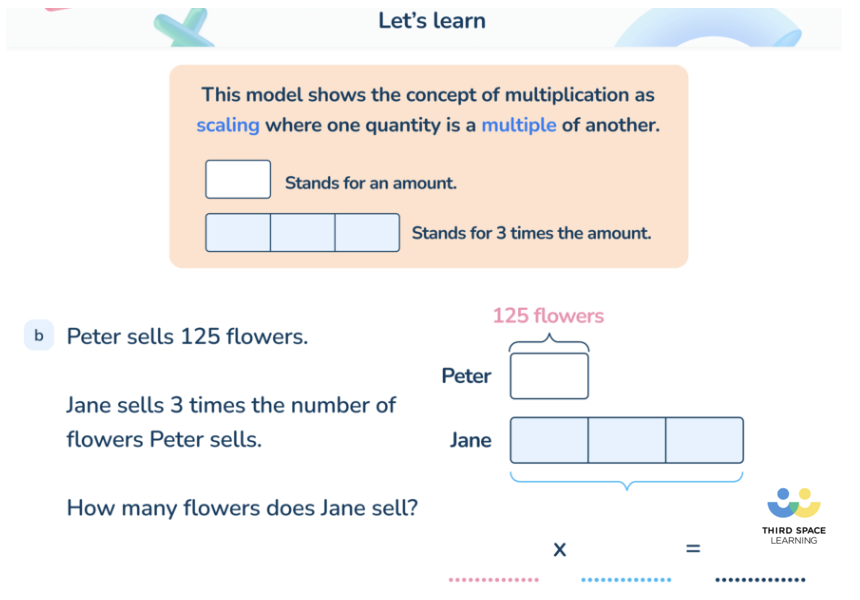
Multiplication word problems for 5th grade
With the end of the elementary school journey in sight, word problems for 5th graders are expected to be able to use mental methods to solve the more simple multiplication word problems, such as multiplying by a multiple of 10. The standard algorithm is formally introduced in 5th grade. They will be able to multiply decimals as well as 4-digit numbers multiplied by 2-digit numbers. They will also be versed with two-step problems and using more than one operation in a question.
Question 1
There are 67 candies in a bag. If the grocery store orders 8,657 bags, how many candies would there be altogether?
Answer: 580,019 candies
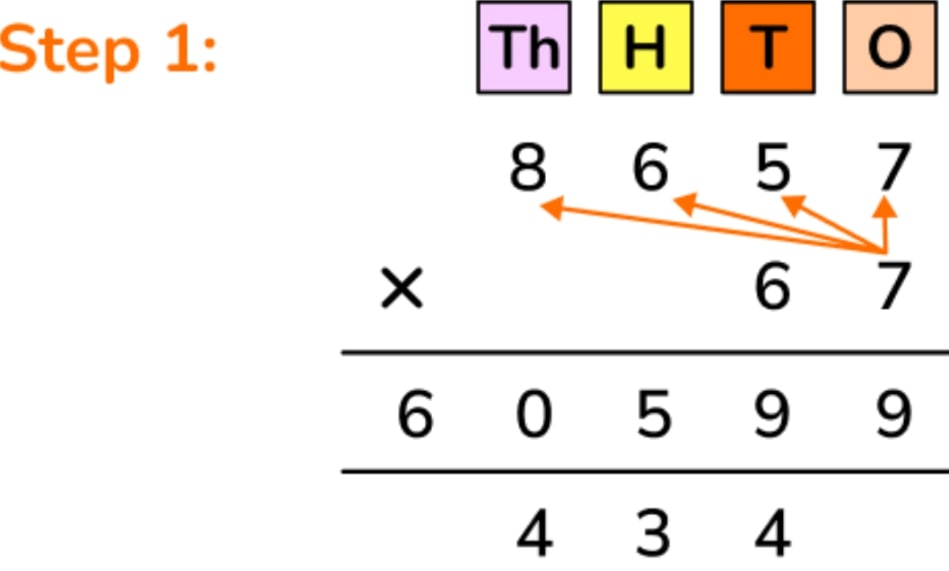
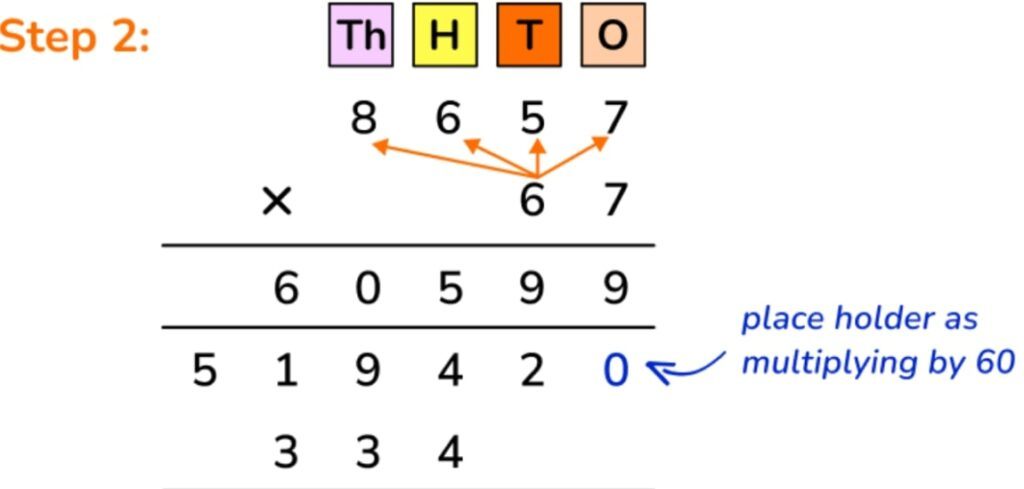

Question 2
Bobby chooses a number between 300 and 320.
She divides it by 6 then subtracts 17 from it.
She then divides that number by 4.
Her answer is 8.5.
What number did she start with?
Answer: 306
Here it is essential to work backwards from the answer 8.5 and do the inverse at each step. So we multiply instead of divide and we add instead of subtract.
Question 3
Miss Dobson is making cakes to sell at the school fair.
Strawberries cost $5.60 per lb.
Eggs cost $1.70 per box.
Icing costs 89¢ per lb.
Cake cases are $3.25 for 10.
She uses 8 lbs of strawberries, 10 boxes of eggs, 11 lbs of icing and 40 cake cases to make 40 cakes.
Calculate the total cost for 40 cakes.
Answer: $84.59
The strawberries are: $5.60 x 8 = $44.80
The eggs are: $1.70 x 10 = $17.00
Icing costs are $0.89 x 11 = $9.79
Cake cases are $3.25 x 4 = $13.00
Question 4
There are 26 white buttons in a pack and 13 blue buttons in a pack.
The school buys 1,460 packs of white buttons and 730 packs of blue buttons.
Is it true that the school would have four times as many white buttons as blue buttons? Show your working in your answer.
Answer: It is true because there are 37,960 white buttons and there are 9,490 blue buttons.
If we then multiply 9,490 by 4 we get 37,960. Or alternatively we could divide 37,960 by 4 and get 9,490.
More word problems resources
Third Space Learning offers a big collection of practice word problems covering a wide range of topics for all elementary grade levels. Take a look at our addition and subtraction word problems, time word problems, ratio word problems and percentage word problems.
Do you have students who need extra support in math?
Skye—our AI math tutor built by experienced teachers—provides students with personalized one-on-one, spoken instruction that helps them master concepts, close skill gaps, and gain confidence.
Since 2013, we’ve delivered over 2 million hours of math lessons to more than 170,000 students, guiding them toward higher math achievement.
Discover how our AI math tutoring can boost student success, or see how our math programs can support your school’s goals:
– 3rd grade tutoring
– 4th grade tutoring
– 5th grade tutoring
– 6th grade tutoring
– 7th grade tutoring
– 8th grade tutoring
The content in this article was originally written by former Deputy Headteacher Steven Eastes and has since been revised and adapted for US schools by elementary math teacher Christi Kulesza.
